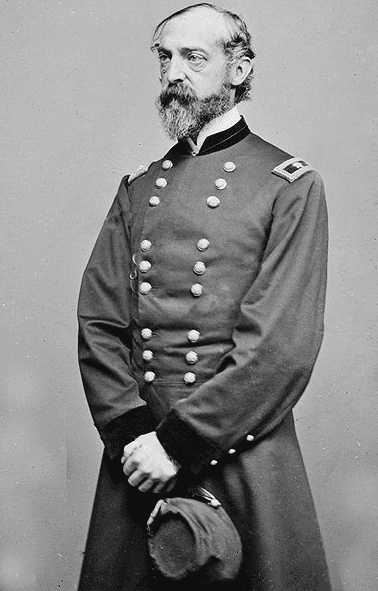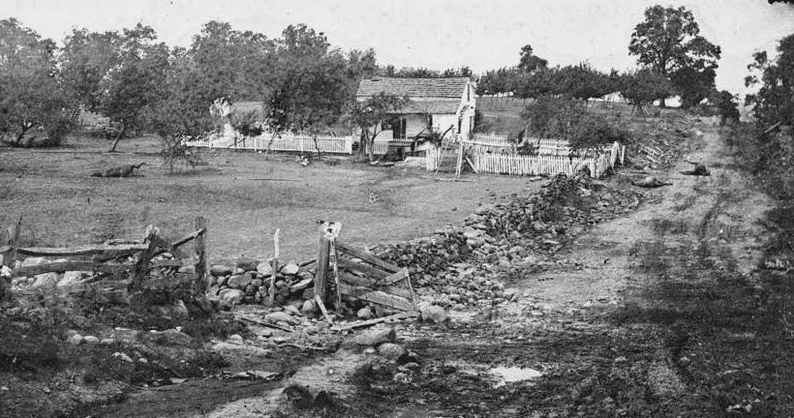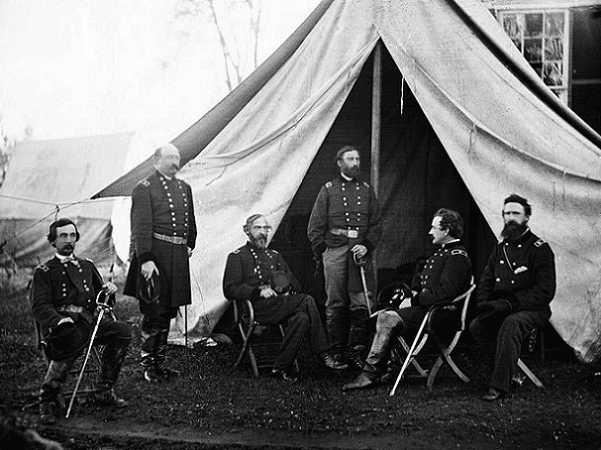After four years of steady fighting in the Eastern Theater of the Civil War, the Union’s famed Army of the Potomac was disbanded on 28 June 1865, having experienced remarkable victories and major defeats in many of the war’s most important battles.
The Army of the Potomac was led by five different commanders during its four-year existence, but only its fifth and final leader, General George G. Meade, was successful. Meade led the army exactly two years, and on his two-year anniversary of assuming command, 28 June 1865, issued his farewell order to the men who had served him and their country so well.

When it was created in 1861, the fighting force was called the Army of Northeastern Virginia. Led by General Irvin McDowell, this was the Union army that fought – and lost – the Civil War’s first major battle, the First Battle of Bull Run (Manassas). Dismayed, President Lincoln replaced McDowell with General George B. McClellan, who combined the Army of Northeastern Virginia with other units in Baltimore, Shenandoah and Washington, D.C., on 26 July 1861, to form the Army of the Potomac.
After McClellan’s prolonged Peninsula Campaign in 1862 failed to capture the Confederate capital of Richmond, Virginia, three of the Army of the Potomac’s corps were placed under the command of General John Pope. Lincoln replaced McClellan with General Ambrose E. Burnside on 19 November 1862. When he did not work out, Lincoln replaced Burnside with General Joseph Hooker on 26 January 1863.
When Hooker, like his predecessors, disappointed the president, Lincoln replaced him with the Army of the Potomac’s final commander, General George G. Meade, on 28 June 1863. Just three days after taking command, Meade found himself embroiled in the epic clash that was the turning point in the Civil War: the Battle of Gettysburg. The new commander ably managed his men and stopped Confederate General Robert E. Lee’s northern invasion at that small Pennsylvania town.

Meade and the Army of the Potomac were directly involved in the steady, bloody grind that wore down Lee’s army in the final two years of the war, and were present at Lee’s surrender at Appomattox Court House on 9 April 1865.
While the formal command of the army remained his, Meade was overshadowed by the North’s military star, General Ulysses S. Grant. Although he was the general-in-chief of all Union armies, Grant kept his headquarters with the Army of the Potomac from May 1864 until the end of the war, receiving the bulk of the press coverage and the public’s acclaim while Meade, for the most part, was ignored.
The Army of the Potomac was involved in major battles in Maryland, Pennsylvania and Virginia, including: First Bull Run (Manassas); the Seven Days Battles during the Peninsula Campaign; Second Battle of Bull Run (Manassas); Antietam; Fredericksburg; Chancellorsville; Gettysburg; Cold Harbor; Richmond-Petersburg Campaign, including the Battle of the Crater; and the Appomattox Campaign, including Lee’s surrender.
To celebrate the end of the Civil War (and to relieve the gloomy mood in the nation’s capital after the assassination of President Lincoln the preceding month), President Andrew Johnson organized a two-day “Grand Review of the Armies” down the streets of Washington, D.C. On the first day, 23 May 1865, General Meade led 80,000 men of the Army of the Potomac past cheering crowds in a seven-mile-long procession of men and horses.
The following three newspaper articles are about the disbanding of the Army of the Potomac. The first article is a reprint of Meade’s farewell order to his army, and the next two are editorials – one praising the army, and the other Meade himself.
Here is a transcription of this article:
Farewell Order of Gen. Meade to His Army
WASHINGTON, June 29. – The farewell order of Gen. Meade is published. It is as follows:
HEAD’TERS ARMY OF THE POTOMAC,
June 28th, 1865.
Soldiers, this day two years ago, I assumed command of you by orders of the President of the United States. To-day, by virtue of the same authority, the army ceasing to exist, I announce my transfer to other duties and my separation from you.
It is unnecessary for me to enumerate all that has occurred in these two eventful years, from the grand and decisive battle of Gettysburg, the turning point of the war, to the surrender of the Army of Northern Virginia at Appomattox Court House.
Suffice it to say that history will do you justice. A grateful country will honor the living, cherish and support the disabled, and sincerely mourn the dead.
In parting from you your commanding General will ever bear in memory your noble devotion to your country, your patience and cheerfulness under all the privations and sacrifices you have been called upon to endure.
SOLDIERS – Having accomplished the work set before us – having vindicated the integrity of our Government and flag – let us return thanks to Almighty God for His blessing, granting us victory and peace; and let us earnestly pray for strength and light to discharge our duties as citizens, as we have endeavored to discharge them as soldiers.
(Signed)
GEO. G. MEADE,
Major-General U.S. Army.
Here is a transcription of this article:
MEADE’S FAREWELL
The Army of the Potomac has ceased to exist. All that remains of that gallant force is a single division of about fifteen thousand men. The remainder have been sent home to be discharged, and large numbers of them, mustered out of service, have doffed their uniforms and gladly sought the repose of private life. General GEORGE G. MEADE, two years from the day when he assumed command of that army, publishes his official announcement of its dissolution. He has no longer a command, and he bids his comrades an affectionate farewell. For two long years of marches and battles, that noble body of troops which had already endured two long years of contest, mingled with victories and defeats, remained steadfast to the great cause; the soldiers were patient amid reverses and happy in each victory, which brought them nearer the end of their service. Gettysburg, Bristow Station, Rappahannock Station, Mine Run, Wilderness, Spottsylvania Court House, Hawes’ Shop, Cold Harbor, Petersburg, Quaker Church, Jerusalem Plank Road, St. Mary’s Church, Deep Bottom, White Tavern, Ream’s Station, Chaffin’s Farm, Poplar Springs, Darbytown Road, Hatcher’s Run, Gravelly Run, Richmond, Sailor’s Creek and Appomattox Court House are inscribed upon their banners. That army grappled with rebellion in its first furious outburst. It strangled it in the hour of its exhaustion. General Meade cursorily refers to these trials and triumphs. It was unnecessary for him to recite them. They are written deeply in the memories of his soldiers, and they will be preserved in the pages of history.
The Army of the Potomac has ceased to exist. It was a gallant army, which suffered much, but never despaired. Its trials at the beginning were borne without murmurs. Its success at the end was received without exultation. The only feeling that its officers and men had, was that they had done their duty. They had vindicated the fame of the organization. They had overcome depressing influences, and conquered by steady valor and unfaltering perseverance. In future times the survivors of that army will look back with satisfaction upon the reminiscences of their toils and sufferings. They will leave to their families the inheritance of patriotism, blessed memories which will increase in glory with time, and be to their descendants the best monition that they should ever remain good and faithful citizens.
Here is a transcription of this article:
General Meade’s Farewell
General MEADE never awakened popular enthusiasm. He has, nevertheless, earned the gratitude of the people. Except during the first few weeks of his service as Chief in command of the Army of the Potomac, he was in immediate subordination to General GRANT and the latter became the prominent figure in the grand drama of the last twelve months of the war. This fact diverted public attention from General MEADE; and he really occupied a less conspicuous position in the records of the campaign than many others having fewer responsibilities.
But it will not be forgotten that with his assumption of the command of the Army of the Potomac, the tide of battle changed, and victory took the place of defeat. McCLELLAN, POPE, BURNSIDE and HOOKER had each failed in the work assigned them; and LEE seemed to be marching on to complete triumph, when General MEADE initiated a series of successes, which finally culminated in the capture of Richmond and the surrender of the Rebel army.
From first to last, Gen. MEADE has borne himself with quiet dignity. Seemingly only anxious to end the war successfully, he did promptly and well whatever work was assigned him. He has sought neither notoriety nor adulation, and retires from the service with the unostentatious grace becoming his high character as a Christian soldier and gentleman.
Note: An online collection of newspapers, such as GenealogyBank’s Historical Newspaper Archives, is not only a great way to learn about the lives of your ancestors – the old newspaper articles also help you understand American history and the times your ancestors lived in, and the news they talked about and read in their local papers. Did any of your ancestors serve in the Civil War? Please share your stories with us in the comments section.
Related Articles:
